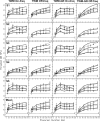Accounting for nonmonotonic precursor duration effects with gain reduction in the temporal window model
- PMID: 24606271
- PMCID: PMC3985874
- DOI: 10.1121/1.4864783
Accounting for nonmonotonic precursor duration effects with gain reduction in the temporal window model
Abstract
The mechanisms of forward masking are not clearly understood. The temporal window model (TWM) proposes that masking occurs via a neural mechanism that integrates within a temporal window. The medial olivocochlear reflex (MOCR), a sound-evoked reflex that reduces cochlear amplifier gain, may also contribute to forward masking if the preceding sound reduces gain for the signal. Psychophysical evidence of gain reduction can be observed using a growth of masking (GOM) paradigm with an off-frequency forward masker and a precursor. The basilar membrane input/output (I/O) function is estimated from the GOM function, and the I/O function gain is reduced by the precursor. In this study, the effect of precursor duration on this gain reduction effect was examined for on- and off-frequency precursors. With on-frequency precursors, thresholds increased with increasing precursor duration, then decreased (rolled over) for longer durations. Thresholds with off-frequency precursors continued to increase with increasing precursor duration. These results are not consistent with solely neural masking, but may reflect gain reduction that selectively affects on-frequency stimuli. The TWM was modified to include history-dependent gain reduction to simulate the MOCR, called the temporal window model-gain reduction (TWM-GR). The TWM-GR predicted rollover and the differences with on- and off-frequency precursors whereas the TWM did not.
Figures





References
Publication types
MeSH terms
Grants and funding
LinkOut - more resources
Full Text Sources
Other Literature Sources
Medical

